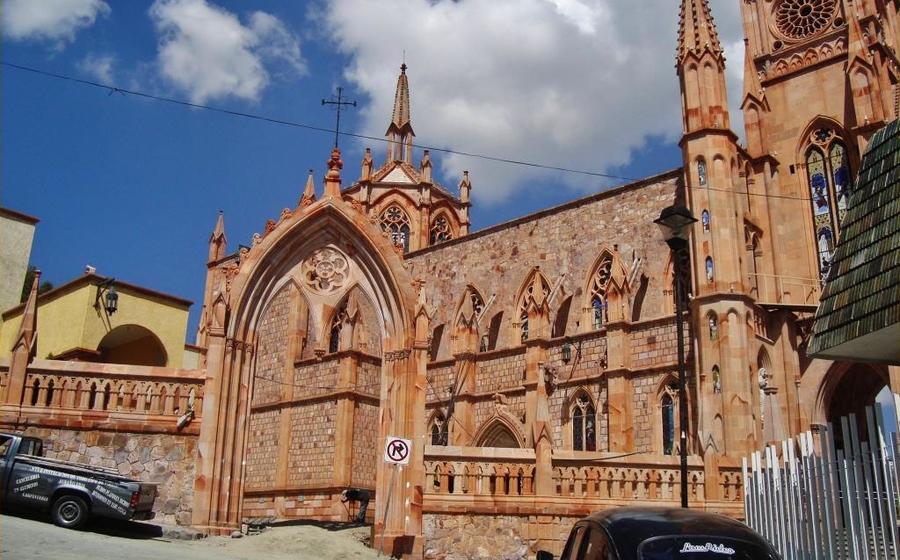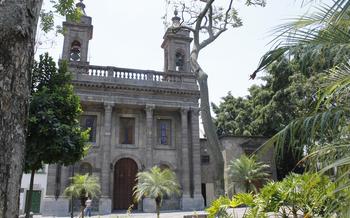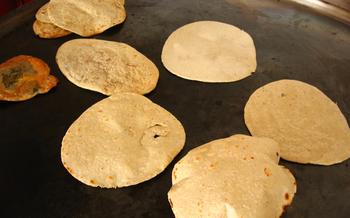
Museo de Arte Sacro
- Museo de Arte Sacro: A Hidden Gem in Zacatecas
- A Journey Through Time: The Museum's History
- Guardians of Faith: The Museum's Collection
- A Glimpse into the Divine: Highlights of the Collection
- Devotion and Ritual: Thematic Galleries
- Interactive Experiences: Engaging with the Collection
- Stepping into History: The Historic Building
- A Cultural Tapestry: The Museum's Role in Zacatecas
- Beyond the Walls: Exploring Zacatecas's Religious Legacy
- Practical Tips for a Memorable Visit
- Photography and Social Media: Capturing the Experience
- Accessibility and Special Needs
- Educational Programs and Workshops
- Insider Tip: Hidden Gems and Secret Spots
Museo de Arte Sacro: A Hidden Gem in Zacatecas
In the heart of Zacatecas, amidst cobblestone streets and colonial architecture, lies a hidden gem that transports visitors back in time: the Museo de Arte Sacro. This remarkable museum, housed within the walls of the historic San Agustín Seminary, is a treasure trove of religious art and artifacts that offer a glimpse into the rich spiritual heritage of the region.
Founded in 1973, the Museo de Arte Sacro was established with the mission of preserving and showcasing the artistic and cultural legacy of Zacatecas's Catholic past. The museum's collection, meticulously curated over decades, umfasst a diverse array of paintings, sculptures, liturgical objects, and vestments that tell the story of faith, devotion, and artistry in this vibrant Mexican state.
Conveniently located just a short walk from the Zacatecas Cathedral, the Museo de Arte Sacro is easily accessible to visitors. The museum is open from Tuesday to Sunday, with varying hours depending on the season. Admission fees are minimal, making it an affordable and accessible attraction for travelers of all budgets.
The museum's architectural features are as captivating as its collection. The San Agustín Seminary, which houses the museum, is a stunning example of colonial architecture, with its ornate facade, intricate arches, and tranquil courtyards. The museum's galleries are thoughtfully designed to enhance the visitor experience, with each room offering a unique perspective on Zacatecas's religious art and history.
A Journey Through Time: The Museum's History
The Museo de Arte Sacro in Zacatecas is a testament to the city's rich religious heritage and cultural legacy. Its history is intertwined with the founding and establishment of the Zacatecas Cathedral, which played a pivotal role in the museum's creation. The cathedral's vast collection of religious art and artifacts formed the foundation of the museum, which was officially established in 198
Over the years, the Museo de Arte Sacro has hosted numerous exhibitions and events, showcasing the diverse artistic expressions of Zacatecas's religious past. These exhibitions have featured a wide range of works, from colonial-era paintings and sculptures to contemporary interpretations of religious themes.
The museum's ongoing conservation and restoration efforts ensure that its collection remains in pristine condition for future generations. Through meticulous care and expertise, the museum's dedicated team preserves the artistic and historical value of these sacred objects, allowing visitors to appreciate their beauty and significance.
Guardians of Faith: The Museum's Collection
The Museo de Arte Sacro in Zacatecas boasts a diverse collection of religious art that offers a glimpse into the city's rich Catholic heritage. Paintings, sculptures, liturgical objects, and textiles from various periods are meticulously preserved and displayed, providing a visual feast for visitors.
Among the notable paintings, the "Last Supper" by Miguel Cabrera stands out for its vibrant colors and intricate details. The sculpture of "Nuestra Señora de Zacatecas" (Our Lady of Zacatecas), patron saint of the city, is a revered object of devotion, adorned with precious metals and jewels.
Liturgical objects such as chalices, monstrances, and reliquaries showcase the artistry and craftsmanship of skilled silversmiths. Their intricate designs and symbolic motifs add to the overall splendor of the collection.
The symbolism and iconography in the artworks are particularly noteworthy. Angels, saints, and biblical scenes are depicted with meticulous attention to detail, conveying messages of faith, hope, and redemption. Each piece tells a story, offering insights into the beliefs and practices of the Catholic Church.
The collection's significance extends beyond its artistic value, as it serves as a testament to Zacatecas's religious heritage. It provides a tangible connection to the city's past, preserving the legacy of faith and devotion that has shaped its identity.
A Glimpse into the Divine: Highlights of the Collection
Among the many remarkable pieces in the Museo de Arte Sacro's collection, a few stand out for their exceptional beauty, historical significance, and artistic merit. One such masterpiece is the 17th-century painting "The Virgin of Guadalupe", attributed to the renowned artist Miguel Cabrera. This iconic depiction of Mexico's patron saint exudes a serene and radiant presence, capturing the hearts of visitors with its intricate details and vibrant colors.
Another highlight is the life-sized sculpture of "Christ on the Cross", carved from a single piece of wood in the 18th century. The intricate craftsmanship and attention to detail in this sculpture evoke a profound sense of awe and devotion. The artist's masterful ability to capture the physical and emotional suffering of Christ leaves an indelible impression on the viewer.
For those interested in liturgical objects, the museum showcases a rare and exquisite collection of silver chalices, monstrances, and reliquaries. These ornate pieces, crafted by skilled silversmiths, demonstrate the exceptional craftsmanship and artistry that went into creating sacred objects. The intricate engravings and delicate filigree work on these pieces are a testament to the deep reverence and devotion that permeated the religious traditions of Zacatecas.
Finally, the museum houses a fascinating collection of ex-votos, or devotional paintings, that offer a glimpse into the personal stories and beliefs of the faithful. These humble yet powerful works of art depict scenes of miracles, answered prayers, and expressions of gratitude. They provide a unique window into the lives and struggles of ordinary people who turned to their faith for solace and protection.
Devotion and Ritual: Thematic Galleries
The Museo de Arte Sacro is divided into several thematic galleries, each exploring a different aspect of Zacatecas's religious heritage. The Gallery of Colonial Art showcases paintings, sculptures, and liturgical objects from the 16th to 18th centuries. Here, visitors can admire masterpieces of the Mexican Baroque style, such as the painting "The Virgin of Guadalupe" by Miguel Cabrera. The Gallery of Modern and Contemporary Art features works created after the Mexican Revolution, reflecting the changing artistic and religious expressions of the 20th and 21st centuries. The Gallery of Popular Art displays traditional crafts and folk art inspired by religious themes, demonstrating the deep-rooted devotion of the local communities. These galleries collectively offer a comprehensive journey through the history of religious art in Zacatecas, providing insights into the evolution of artistic styles, iconography, and the relationship between art and faith.
Interactive Experiences: Engaging with the Collection
The Museo de Arte Sacro offers a range of interactive elements and multimedia presentations to enhance the visitor's experience and foster a deeper engagement with the collection. Interactive touchscreens and digital displays provide detailed information about the artworks, allowing visitors to delve into their history, symbolism, and techniques.
The museum also offers educational programs and workshops designed to engage visitors of all ages. These programs include guided tours led by knowledgeable docents who share insights into the collection and its significance. Art workshops and classes provide hands-on experiences for visitors to create their own artistic interpretations of the religious themes explored in the museum.
Through these interactive elements and educational initiatives, the Museo de Arte Sacro creates a dynamic and engaging experience that encourages visitors to explore, learn, and connect with the rich cultural and religious heritage of Zacatecas.
Stepping into History: The Historic Building
Nestled within the heart of Zacatecas's historic center, the Museo de Arte Sacro finds its home in a building that whispers tales of the city's rich past. Erected in the 18th century, the building served as a seminary, a place where young men devoted themselves to the study of theology and the pursuit of a spiritual path. Its walls have witnessed generations of aspiring priests seeking knowledge and enlightenment, their footsteps echoing through the corridors as they traversed the journey of faith.
The architectural style of the building reflects the prevalent trends of the era, showcasing a harmonious blend of Baroque and Neoclassical elements. Its elegant facade, adorned with intricate carvings and graceful arches, hints at the artistic treasures that lie within. As you step through the grand entrance, the building's history unfolds before you, inviting you to embark on a journey through time and devotion.
A Cultural Tapestry: The Museum's Role in Zacatecas
The Museo de Arte Sacro is not just a repository of religious artifacts; it is an integral part of Zacatecas's cultural fabric. It plays a pivotal role in preserving and promoting the city's rich religious heritage, which is deeply intertwined with its history and identity. The museum's collection offers a glimpse into the faith, traditions, and artistic expressions of the Zacatecan people.
Through its exhibitions, educational programs, and community outreach initiatives, the museum fosters a sense of cultural pride and appreciation for the city's religious legacy. It collaborates with local schools, universities, and cultural organizations to organize workshops, lectures, and guided tours, ensuring that the museum's treasures are accessible and meaningful to a diverse audience.
Furthermore, the museum has been instrumental in restoring and conserving religious landmarks and artworks throughout Zacatecas. Its conservation efforts have contributed to the preservation of the city's historic churches, convents, and other religious sites, ensuring that future generations can continue to appreciate their beauty and significance.
The Museo de Arte Sacro stands as a testament to the enduring power of faith and the importance of preserving cultural heritage. It is a place where visitors can not only admire stunning works of art but also gain a deeper understanding of Zacatecas's spiritual and cultural roots.
Beyond the Walls: Exploring Zacatecas's Religious Legacy
Zacatecas's religious heritage extends far beyond the Museo de Arte Sacro. The city is home to numerous other churches, convents, and religious landmarks that offer a glimpse into its rich Catholic history. A must-visit is the Catedral de Zacatecas, a stunning 18th-century Baroque masterpiece that dominates the city's skyline. The cathedral houses an impressive collection of religious art, including paintings, sculptures, and silverwork, and is a testament to the city's deep-rooted faith.
Other notable religious sites include the Templo de San Francisco, with its intricate Churrigueresque façade, and the Convento de Guadalupe, which houses a museum dedicated to the history of the Virgin of Guadalupe, Mexico's patron saint. For a comprehensive exploration of Zacatecas's religious heritage, consider joining a guided tour or following a self-guided itinerary that takes you to the city's most important religious sites. Whether you're a devout Catholic or simply interested in history and culture, Zacatecas offers a wealth of experiences for those seeking to delve deeper into its religious legacy.
Practical Tips for a Memorable Visit
To make the most of your visit to the Museo de Arte Sacro, consider planning your trip during the week to avoid the weekend crowds. This will allow you to explore the museum at a more leisurely pace and appreciate the tranquility of the space.
Combine your visit to the museum with other nearby attractions to create a comprehensive cultural experience. The museum is conveniently located near the Zacatecas Cathedral, Plaza de Armas, and other historical landmarks, making it easy to explore multiple sites in one day.
Take advantage of guided tours to gain deeper insights into the museum's collection. Knowledgeable guides can provide historical context, explain the symbolism of the artworks, and share fascinating stories behind the pieces. Audio guides are also available for those who prefer a self-paced exploration.
After your visit, indulge in a delicious meal at one of the many restaurants or cafes located near the museum. This is a great way to savor the local cuisine and extend your cultural immersion.
Photography and Social Media: Capturing the Experience
Visitors are encouraged to capture their museum experience through photography, but with respect for the artwork and other visitors. Flash photography and tripods are not permitted to ensure the preservation of the delicate artworks. Sharing experiences on social media is welcomed, and visitors are encouraged to use specific hashtags or geotags for the museum to connect with a broader community of art enthusiasts. The museum actively maintains a presence on social media platforms, providing updates on exhibitions, events, and educational programs. Visitors can follow the museum's social media accounts to stay informed and engaged with the museum's community.
Accessibility and Special Needs
The Museo de Arte Sacro is committed to ensuring that everyone has an enjoyable and accessible visit. The museum is wheelchair accessible, with ramps and elevators providing access to all floors. There are also designated parking spaces for visitors with disabilities located near the museum entrance.
For visitors with visual impairments, the museum offers audio guides and Braille signage. Assistive listening devices are available for visitors with hearing impairments. The museum's staff is also trained to assist visitors with special needs, and they are happy to provide any additional assistance that may be required.
In addition, the museum offers a variety of educational programs and workshops that are designed to be inclusive and accessible to everyone. These programs are open to visitors of all ages and abilities, and they provide a great opportunity to learn more about the museum's collection and the history of religious art in Zacatecas.
Educational Programs and Workshops
The Museo de Arte Sacro is committed to promoting art education and engaging with students and families through a variety of educational programs and workshops. These programs are designed to foster appreciation for religious art, history, and culture while providing hands-on learning experiences.
The museum offers guided tours tailored to different age groups, allowing students to explore the collection while learning about the significance of the artworks and the history of the museum. Interactive workshops, such as painting classes and art history lectures, are also organized regularly, providing participants with opportunities to create their own artworks and deepen their understanding of the museum's collection.
Families can take part in special family days or weekend workshops, where parents and children can engage in creative activities together, fostering intergenerational learning and bonding. The museum also collaborates with local schools and educational institutions to develop tailored programs that align with their curricula, bringing art education directly to students in the classroom.
These educational initiatives aim to inspire a new generation of art enthusiasts and promote the preservation and appreciation of Zacatecas's rich religious heritage, ensuring that the Museo de Arte Sacro continues to play a vital role in shaping the city's cultural landscape.
Insider Tip: Hidden Gems and Secret Spots
Beyond the main galleries, the Museo de Arte Sacro holds a few hidden gems that are often overlooked by visitors. One such gem is the small chapel located in the back of the museum. This intimate space features a beautifully preserved 18th-century altarpiece dedicated to the Virgin Mary. The intricate carvings and vibrant colors of the altarpiece are a testament to the skill of the anonymous artist who created it. Visitors who take the time to explore this hidden chapel will be rewarded with a truly special experience.









